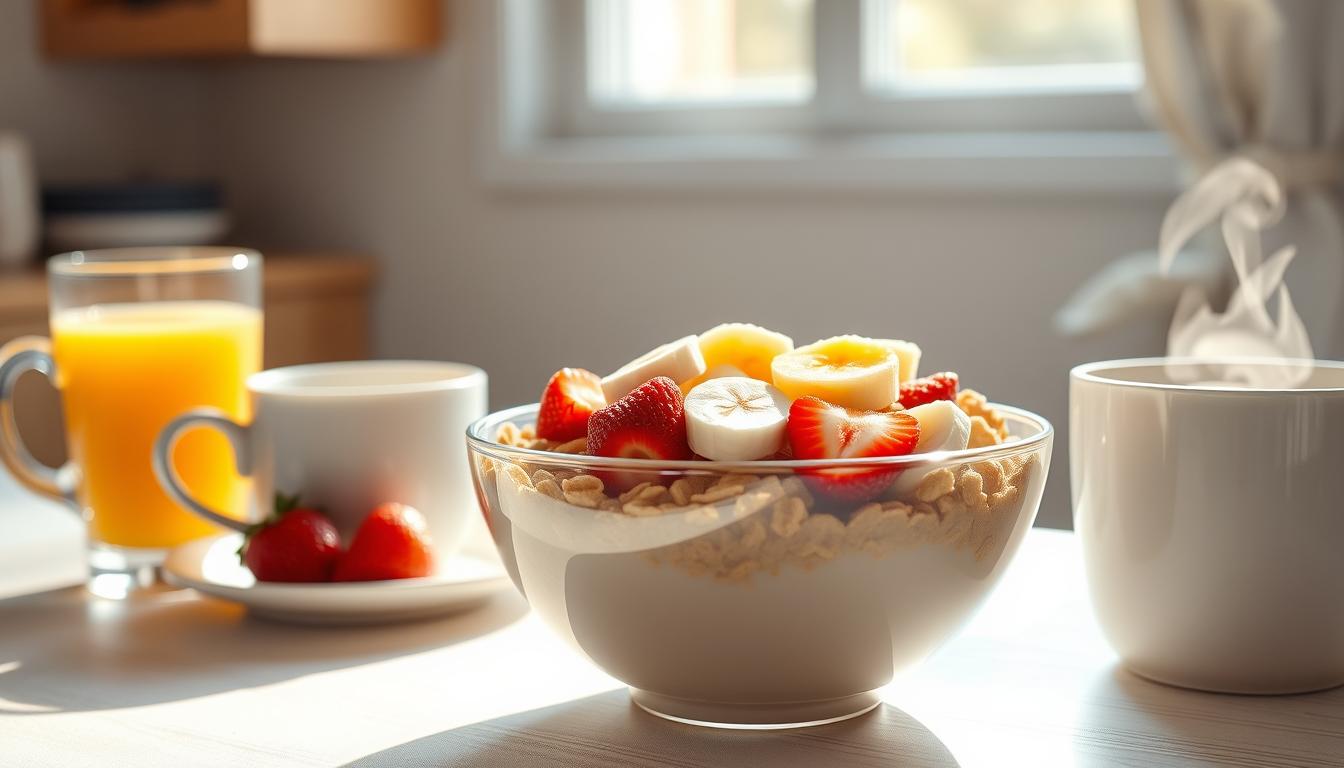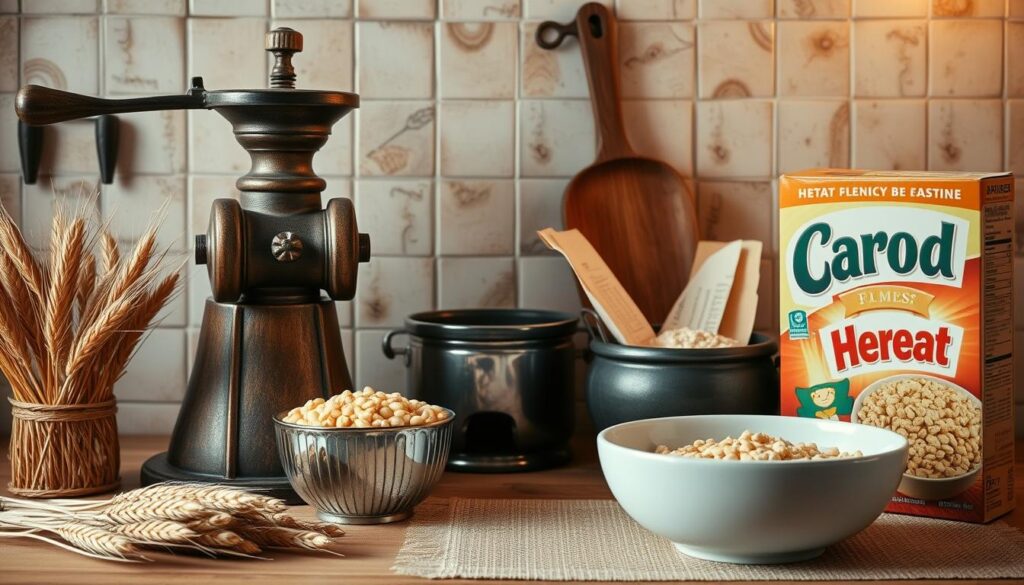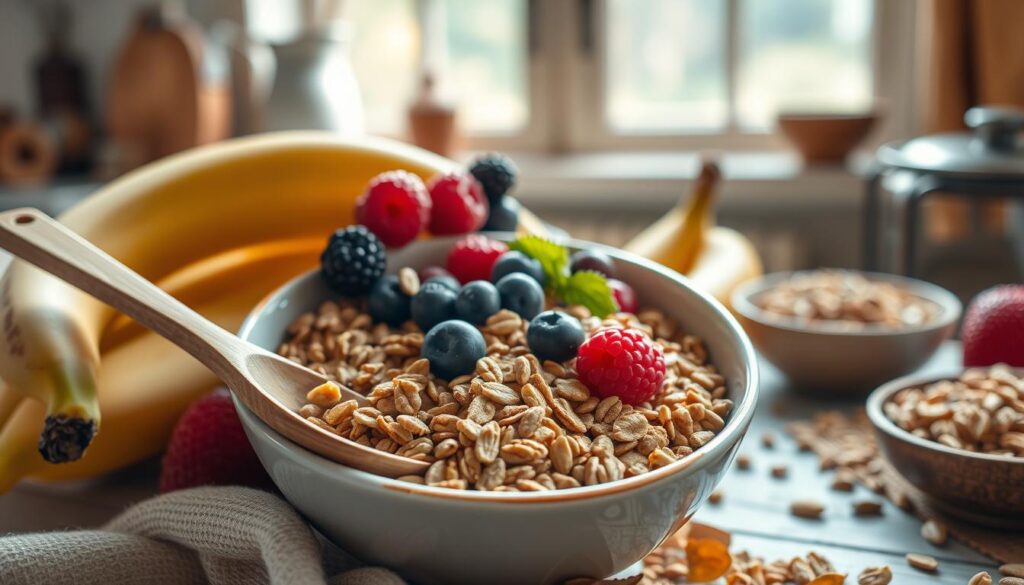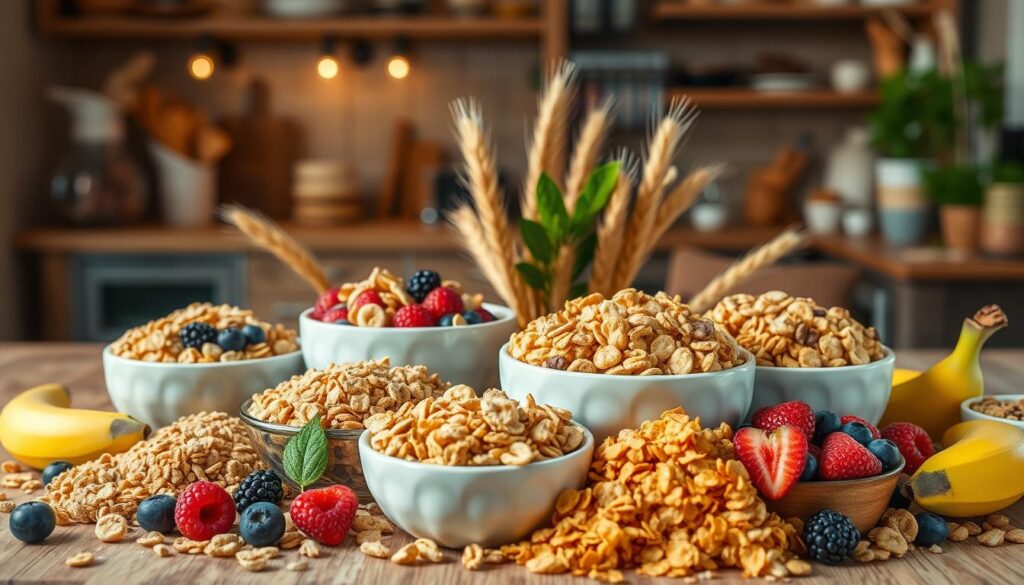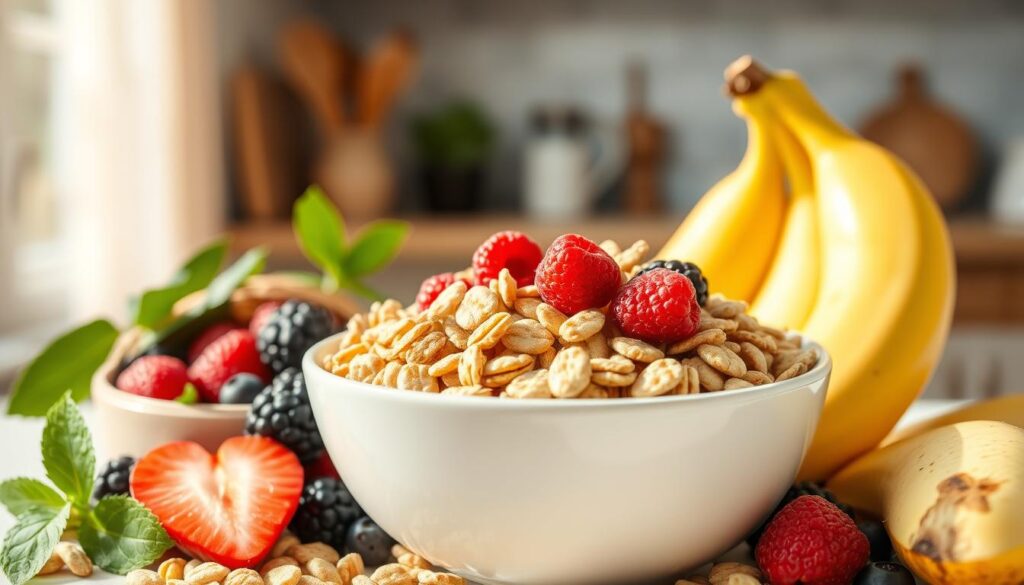Every morning, the sun lights up your kitchen. You face a simple yet powerful choice. Your breakfast is more than just a meal; it’s fuel for your day and a moment of nourishment.
Wheat cereal is not just a breakfast food. It’s a key to sustained energy, wellness, and vitality.
The world of whole grains has changed how we view breakfast. Wheat cereal is a nutritional powerhouse. It’s packed with essential minerals, complex carbohydrates, and a rich history of nourishment.
From ancient fields to your breakfast table, wheat has been a source of nourishment for thousands of years.
Health-conscious people are finding the benefits of wheat cereal. They’re moving away from processed breakfasts. Instead, they choose whole grain cereals for steady energy, digestive health, and overall wellness.
Key Takeaways
- Wheat cereal offers a nutritious start to your day
- Whole grains provide sustained energy and essential minerals
- Breakfast choices impact overall health and performance
- Wheat has been a dietary staple for thousands of years
- Modern wheat cereals represent a blend of tradition and nutrition
The Rich History of Wheat Cereal: From Accident to Breakfast Icon
The story of cereal is full of innovation and unexpected moments. In 1898, a batch of wheat dough was left alone. This led to the creation of crispy, crunchy flakes that changed breakfast forever in America.
John Harvey Kellogg and his brother Will were the pioneers of cereal brands. They started making healthier food options. Will Kellogg’s idea to add sugar to corn flakes made cereals more popular.
The Birth of Wheaties in 1921
Wheaties was created by accident in 1921. It was the first ready-to-eat wheat cereal. It quickly became a hit in America.
- Created accidentally in 1921
- First ready-to-eat wheat cereal
- Pioneered sports marketing in cereal branding
Evolution Through the Decades
By the mid-20th century, cereals grew a lot. The number of cereals went from about 160 in 1970 to 340 by 1998. The breakfast cereal industry became a powerhouse of innovation and marketing.
Historical Marketing Milestones
Cereal marketing changed when brands started using athletes on their boxes. Wheaties’ “Breakfast of Champions” campaign made cereals seem like a healthy choice for athletes.
“Breakfast of Champions” – more than just a slogan, but a cultural phenomenon
Wheat cereal’s journey from accident to staple shows American ingenuity and spirit.
Understanding the Nutritional Power of Wheat Cereal
Wheat cereal is a nutritional powerhouse. It gives you essential nutrients for health and wellness. It’s packed with vitamins, minerals, and fiber, making it more than just a tasty breakfast.
Essential Vitamins and Minerals
Your body needs nutrients, and wheat cereal provides them. Fortified cereals give up to 100% of the daily recommended amounts of important nutrients:
- B vitamins for energy metabolism
- Iron for healthy blood circulation
- Magnesium for muscle and nerve function
- Zinc for immune system support
Protein and Fiber Content
Wheat cereal is a great source of protein and fiber. It has protein from 8% to 20% of total calories. The fiber helps with digestion and weight management.
*”Fiber is your digestive system’s best friend – aim for 25-30 grams daily”*
| Nutrient | Amount per Cup | Daily Value |
|---|---|---|
| Calories | 345 | 17% |
| Protein | 13g | 26% |
| Fiber | 5-8g | 20-32% |
| Carbohydrates | 78g | 26% |
Caloric Value and Daily Requirements
Knowing your daily nutritional needs is important. Wheat helps meet those needs. Eating whole grains can lower heart disease risk by 25% and type 2 diabetes risk by 22%.
Adding wheat to your diet is more than just eating. It’s investing in your health and wellness for the long term.
The Complete Guide to Different Types of Wheat Cereal
Exploring wheat cereal shows a wide range of options for breakfast. You can find everything from classic wheat flakes to gluten-free choices. There’s a cereal for everyone, no matter your taste or dietary needs.
Knowing about different wheat cereals helps you pick the best for breakfast. Let’s explore the world of cereal brands and their special offerings:
- Classic Wheat Flakes: The traditional cereal that started it all, full of whole grain goodness
- Organic Wheat Options: Premium cereals from sustainably sourced wheat
- Gluten-Free Wheat Alternatives: New cereals for those with dietary restrictions
brands have changed wheat cereal, offering many choices for different needs. When picking your cereal, think about:
- Protein content
- Fiber density
- Sugar levels
- Nutritional additives
“Not all wheat cereals are created equal – choose wisely for optimal nutrition!”
Gluten-free options are getting more popular for those with special diets. Today, cereal brands offer wheat-like cereals that taste and are nutritious like traditional wheat, but without it.
| Cereal Type | Protein (g) | Fiber (g) | Gluten Status |
|---|---|---|---|
| Classic Wheat Flakes | 4 | 3 | Contains Gluten |
| Gluten-Free Wheat Alternative | 3 | 2 | Gluten-Free |
Whether you want traditional wheat cereal or gluten-free options, there’s something for you. Your perfect breakfast is just a bowl away!
Health Benefits and Wellness Advantages
Wheat cereal is more than a tasty breakfast—it’s a nutritional powerhouse. It’s full of whole grains and essential nutrients. These cereals boost your overall wellness.
Exploring wheat cereal’s benefits can change how you view nutrition and health. This simple food can greatly improve your well-being.
Digestive Health Support
Wheat cereal is great for your digestive system. It’s rich in dietary fiber. This helps keep your gut healthy and prevents digestive problems.
- Promotes regular bowel movements
- Supports healthy gut microbiome
- Reduces risk of digestive disorders
Weight Management Benefits
Having trouble with weight control? Wheat cereal’s whole grains can help. The fiber keeps you full longer, which means you eat fewer calories.
| Nutrient | Amount per Serving |
|---|---|
| Calories | 76 |
| Fiber | 4 grams |
| Protein | 3 grams |
Energy and Performance Enhancement
Wheat cereal gives you sustained energy from complex carbs. These grains release energy slowly. This keeps you focused and energized all day.
“Starting your day with whole grains can significantly improve your mental and physical performance.” – Nutrition Expert
- Stabilizes blood sugar levels
- Provides essential nutrients
- Supports cardiovascular health
Choosing wheat is more than just eating. It’s an investment in your long-term health and wellness.
How to Choose the Best Wheat Cereal Brands
Finding the right cereal can be tough. There are so many choices. Your breakfast choice affects your health and nutrition.
When looking at cereal brands, keep these points in mind:
- Ingredient Quality: Look for whole grains as the first ingredient
- Sugar Content: Aim for cereals with less than 6 grams of added sugar
- Protein Level: Select brands offering 9-13 grams of protein per serving
- Fiber Content: Choose cereals with higher fiber percentages
Organic cereals have extra benefits. They often have fewer processed ingredients and less pesticide exposure. Kashi Go and KIND are great organic cereal choices that taste good and are nutritious.
“Your breakfast cereal should fuel your body, not just fill it” – Nutrition Expert
Nutritional labels are key. Look at serving sizes, which vary from 2/3 cup to 1.5 cups. Also, check the vitamin and protein content. For example, Cheerios has about 20% of your daily vitamin D in one serving.
| Cereal Brand | Added Sugar | Protein |
|---|---|---|
| Kashi Go | 7g | 9-13g |
| KIND Granola | 7g | 5-8g |
| Nature Valley | 15g | 10g |
The top wheat brands focus on whole grain nutrition. They also have less added sugar and support your diet goals.
Creative Ways to Prepare and Serve Your Wheat Cereal
Wheat cereal is more than just a simple breakfast. It’s a versatile ingredient that can change your morning and cooking. Whether you’re busy or love to cook, these new ways to make cereal will make your mornings better.
Classic Preparation Methods
Begin with the traditional way to make cereal. Here are some basic steps:
- Hot wheat cereal with milk or water
- Cold wheat cereal with chilled milk
- Overnight soaking for better texture
Modern Serving Suggestions
Turn your wheat cereal into exciting breakfasts with these ideas:
- Make a nutrient-packed breakfast bowl with fresh fruits
- Add Greek yogurt for protein
- Sprinkle nuts and seeds for crunch
Recipe Innovations
Discover new uses for wheat cereal beyond breakfast with these recipes:
| Recipe | Preparation Time | Serving Size |
|---|---|---|
| Wheat Cereal Energy Bars | 15 minutes | 12 bars |
| Cereal Smoothie | 5 minutes | 2 servings |
| Savory Cereal Crusted Chicken | 30 minutes | 4 servings |
“Creativity in the kitchen starts with reimagining simple ingredients like wheat cereal.” – Culinary Innovator
Exploring these different ways to make wheat cereal shows it’s more than a simple breakfast. Try new things, have fun, and enjoy the health benefits of this versatile grain!
Understanding Wheat Cereal Nutrition Labels
Reading nutrition labels on wheat cereal can be tough. But knowing what they say helps you choose better foods for your health.
Look closely at the nutrition labels. They tell you a lot about the cereal’s health benefits. The serving size is key – it’s usually 1 cup. Here are the important facts to watch:
- Calories per serving
- Fiber content
- Protein amount
- Sugar levels
- Essential minerals
Fiber is very important. Wheat cereals have different amounts of fiber, from 0 to 18 grams per serving. More fiber means better digestion.
“Know your nutrition label – it’s your roadmap to healthier eating” – Nutritional Experts
Here’s a look at how different wheat cereals compare:
| Cereal Brand | Calories | Fiber (g) | Protein (g) | Sugar (g) |
|---|---|---|---|---|
| Cheerios | 100 | 3 | 4 | 1 |
| All Bran Buds | 130 | 18 | 5 | 13 |
| Ezekiel 4:9 | 400 | 12 | 16 | 2 |
Nutrition labels are your guide to meeting your daily needs. Soon, cereals will have less than 6 grams of added sugars per dry ounce. This will help make breakfasts healthier.
Sustainable Production and Packaging Practices
The world of organic cereals is changing fast. Sustainability is now a big deal for makers. As people care more about the planet, how cereals are made and packaged is changing too.
Environmental Impact of Wheat Cereal Production
Wheat farming has big environmental problems. Every year, we grow between 623 and 773 million tons of wheat. This creates a lot of waste, about 4.5 million tons.
The impact of making cereals includes:
- Water use in wheat farming
- Keeping soil healthy
- Greenhouse gases from farming
Packaging Innovations in Organic Cereals
The market for green packaging is growing fast. It’s expected to jump from USD 278.1 billion in 2023 to USD 391.1 billion by 2029. New ideas in cereal packaging include:
| Packaging Type | Environmental Benefits |
|---|---|
| Kraft Paper Bags | 100% recyclable and biodegradable |
| Plant-based Plastics | Less need for oil-based plastics |
| Biodegradable Materials | Less waste over time |
Future of Cereal Production
The future of organic cereals is bright. New tech is making farming greener. Makers are finding ways to cut down on harm to the environment without losing taste or nutrition.
“Sustainability is not just a trend, but a necessary evolution in food production.” – Environmental Food Researcher
By picking organic cereals with green packaging, you help the planet and stay healthy. It’s a win-win for breakfast.
Conclusion
Wheat cereal is more than just a breakfast food. It’s a key solution to global dietary problems. Wheat is a big part of what we eat worldwide, especially in developing countries. Choosing whole grains can greatly improve health for you and your community.
When you pick a wheat cereal, you’re getting more than just a quick meal. These foods are packed with vitamins, minerals, protein, and fiber. They help with weight control, brain function, and blood sugar balance.
The world of cereal is full of variety, from old recipes to new ones. By reading nutrition labels and choosing sustainable options, you can make your breakfast a health boost. Your choices help not just you but also the world’s nutritional needs.
See wheat cereal as a key part of your diet. Every bowl is not just breakfast. It’s part of a global effort for better health, sustainability, and creativity in cooking.
FAQ
What exactly is wheat cereal?
Wheat cereal is a breakfast food made from whole wheat grains. It’s processed into flakes or shapes. It’s a nutritious start to your day, offering fiber and complex carbs.
Wheat cereals can be hot or cold. They come in traditional flakes and new formats.
Is wheat cereal good for weight management?
Yes, wheat cereal helps with weight management. Its high fiber content keeps you full. This can reduce calorie intake.
The complex carbs give you energy. This helps control hunger and supports healthy eating.
Are there gluten-free wheat cereal options?
Yes, many brands offer gluten-free alternatives. They use grains like rice, corn, or gluten-free oats. Always check the packaging for gluten-free certifications.
How can I make wheat cereal more interesting?
Add fresh fruits, nuts, seeds, or honey to your cereal. Mix it into smoothies or use it as a yogurt topping. You can also add it to homemade granola or baked goods.
What should I look for on a wheat cereal nutrition label?
Look for high fiber, low added sugars, and protein. Check for vitamins and minerals like iron, B vitamins, and vitamin D.
How does wheat cereal contribute to heart health?
Whole grain wheat cereals support heart health. They have soluble fiber, which can lower cholesterol. The complex carbs and nutrients in wheat cereals contribute to cardiovascular wellness.
Can wheat cereal be part of an organic diet?
Yes, many brands offer organic wheat cereals. These are made from grains grown without synthetic pesticides or fertilizers. They’re a great choice for a healthier breakfast.
How can I store wheat cereal to maintain its freshness?
Store wheat cereal in a cool, dry place. Keep it in its original packaging or an airtight container. Avoid humidity and direct sunlight to keep it fresh.
Are there sustainable options?
Yes, many brands focus on sustainable production. They use responsible farming, reduce packaging waste, and grow organically. Look for brands that care about the environment.
How much wheat cereal should I eat per serving?
Serving sizes vary from 3/4 to 1 cup. Check the nutrition label for the right amount. Adjust based on your needs and goals.

